calsfoundation@cals.org
Phillips County
| Region: | Southeast |
| County Seat: | Helena-West Helena |
| Established: | May 1, 1820 |
| Parent County: | Arkansas |
| Population: | 16,568 (2020 Census) |
| Area: | 690.36 square miles (2020 Census) |
Historical Population as per the U.S. Census:
|
1810 |
1820 |
1830 |
1840 |
1850 |
1860 |
1870 |
1880 |
1890 |
1900 |
|
– |
1,197 |
1,152 |
3,547 |
6,935 |
14,877 |
15,372 |
21,262 |
25,341 |
26,561 |
|
1910 |
1920 |
1930 |
1940 |
1950 |
1960 |
1970 |
1980 |
1990 |
2000 |
|
33,535 |
44,530 |
40,683 |
45,970 |
46,254 |
43,997 |
40,046 |
34,772 |
28,838 |
26,445 |
|
2010 |
2020 |
|
|
|
|
|
|
|
|
|
21,757 |
16,568 |
| Population Characteristics as per the 2020 U.S. Census: | ||
| White |
5,616 |
33.9% |
| African American |
10,343 |
62.4% |
| American Indian |
44 |
0.3% |
| Asian |
65 |
0.4% |
| Native Hawaiian or Other Pacific Islander |
4 |
0.0% |
| Some Other Race |
87 |
0.5% |
| Two or More Races |
409 |
2.5% |
| Hispanic Origin (may be of any race) |
264 |
1.6% |
| Population Density |
24.0 people per square mile |
|
| Median Household Income (2019) |
$29,320 |
|
| Per Capita income (2015–2019) |
$18,651 |
|
| Percent of Population below Poverty Line (2019) |
34.5% |
|
Phillips County is part of the Delta region of Arkansas. Located where the St. Francis River empties into the Mississippi River, its significance touches on nearly every aspect of the state’s history. In the twentieth century, Phillips County was known for devastating flooding, harsh racial confrontations, and the development of blues music.
Phillips County’s soil consists of alluvial deposits from the Mississippi River, making it prime agricultural land. The southern edge of Crowley’s Ridge provides higher land once used by Native Americans. Helena’s location on the Mississippi River gave it the potential to be an important transportation hub, although it eventually was overtaken in importance by Memphis, Tennessee.
Pre-European Exploration
Because of its location, the area was well populated long before European explorers arrived. The Hopewell culture of the Woodland period (600 BC–AD 1000) is represented by a variety of artifacts found in the county. These remains show the influence both of tribes of the northern Mississippi River and Ohio River valleys and of the Marksville culture of the lower Mississippi and Red River valleys, indicating that the area was a crossroads and a meeting place of North American cultures. Most spectacular, though, are the mounds at the Helena Crossing Site. Located at the southern tip of Crowley’s Ridge, they held the remains and personal possessions of several people interred about 2,000 years ago in elaborate log-lined tombs. In the twentieth century, the construction of highways and buildings destroyed much of the area’s archaeological treasures. Spear points and other artifacts have been found in most parts of the county.
European Exploration and Settlement
French and Spanish explorers traveling the Mississippi River undoubtedly saw Phillips County and even landed on its shores, but they did not remark on it or influence it. By the beginning of the nineteenth century, though, settlers from the eastern United States had arrived in what would become Phillips County. Sylvanus Phillips, for whom the county was named, was living there by 1797, having come from North Carolina. Daniel Mooney and William Patterson arrived about the same time. Patterson’s son John Patterson, born around 1800, was the first child not of Indian parents born in Phillips County.
Louisiana Purchase through Early Statehood
The Arkansas territorial legislature established Phillips County out of Arkansas County on May 1, 1820, naming it for the early settler, who also was a member of the first territorial legislature. The county was laid out and surveyed by Nicholas Rightor the following year. In 1811, the steamboat New Orleans had stopped at the mouth of the St. Francis River, demonstrating the viability of the location as a water transportation hub. The city of Helena, incorporated on November 16, 1833, grew up in that location; it was named for the daughter of Sylvanus Phillips. Among its first buildings was a two-story log structure that featured the county courthouse on the upper floor and the county jail on the lower. Phillips County was reduced in size twice: first when Monroe County was established in 1829, and later when Lee County was established in 1873. The point where the three counties meet is the site where the original survey for the lands added to the United States by the Louisiana Purchase began. It is today commemorated by the Louisiana Purchase State Park.
The first school in Phillips County opened on April 25, 1836, on North Ohio Street in Helena and was operated by John Hornor. Many other schools and academies opened in Helena and in other parts of the county in following years, but few lasted more than a year or two. The leaders of Helena hoped to see their city included in the first railroad lines built in Arkansas, but instead the railroad developed between Memphis and Little Rock (Pulaski County).
In addition to transportation, agriculture and lumber were the early industries of the county. The first sawmill was built in 1826. Like most Delta counties, Phillips County was a cotton-producing area, containing large plantations with many African-American slaves. In the 1840 census, only 905 of the 3,547 people living in Phillips County were slaves; but by 1860, 8,941 of the 14,877 residents were slaves. Snow Lake, one plantation settlement in the south part of the county, included fourteen homesteads sheltered by the Laconia Circle Levee, said to be the first levee built on the west bank of the Mississippi River. Constructed piecemeal by workers for the various property owners, it encircled eighteen square miles of prime farmland built up from centuries of river flooding.
At least three enslaved people were lynched in the county before the Civil War. Two unknown men were burned to death in 1849 after allegedly killing their owner. Ten years later, another unknown man was killed after allegedly murdering an overseer.
Civil War through Reconstruction
At the beginning of the Civil War, many of the men of Phillips County volunteered to fight on behalf of the Confederacy, providing enough companies to fill three regiments. The most famous company was the Yell Rifles, led by Patrick Cleburne, a native of Ireland who had lived in Helena since 1850. An artillery unit known as the Helena Battery and organized in that city served for the entire war in the Western Theater.
Federal forces occupied Helena in July 1862. Under the command of Major General Samuel Ryan Curtis, the Union’s Army of the Southwest moved across northern Arkansas and southern Missouri after the Battle of Pea Ridge in an effort to capture Little Rock. Unable to do so, the Federals captured Helena, which allowed them to receive supplies via the Mississippi River. Strategists on both sides understood the importance of this river port, located between Memphis and Vicksburg, Mississippi. On July 4, 1863, Confederate forces led by Lieutenant General Theophilus H. Holmes attacked the Union position from several directions, in what is known as the Battle of Helena, but were unable to dislodge the opposition. Over 1,600 Confederate casualties were reported in the battle, compared to 239 Union losses. Confederate leaders thought the battle would relieve pressure on their comrades at Vicksburg, but on the same day, Confederate forces in Vicksburg surrendered to Union forces led by General Ulysses S. Grant.
Another significant conflict occurred in Phillips County about a year after the Battle of Helena. In the Action at Wallace’s Ferry on July 26, 1864, two Union forces were ambushed by cavalrymen from Arkansas and Missouri while crossing Big Creek. Nineteen Union soldiers and at least seven Confederate soldiers died in the action, which did not significantly alter the course of the war. Numerous other engagements took place in the county, including at Lick Creek, Polk’s Plantation, Lamb’s Plantation, and along the St. Francis Road.
Helena proved to be an important Union stronghold for the remainder of the war. Thousands of formerly enslaved people fled to the city and entered the protection of the Federal troops garrisoning the town. Fortifications were constructed around the town and many formerly enslaved men joined military units, while others along with women and children were eventually placed on Federally managed plantations. Battery E of the Second U.S. Colored Artillery (Light) organized in Helena in late 1863 and spent its entire service in and around the city. Other units organized in the county included the Forty-sixth U.S. Colored Troops, Fifty-fourth U.S. Colored Infantry, and 112th United States Colored Infantry. Fort Curtis served as the key to the defenses of the city, and a replica of the structure was constructed in 2005.
A Confederate cemetery holds the bodies of men killed at the Battle of Helena and in other actions, as well as the body of Patrick Cleburne, returned to Arkansas after the war.
In 1864, Quaker missionaries Alida and Calvin Clark arrived in Helena to operate an orphanage for lost and abandoned Black children. Two years later, the orphanage was moved to a rural site nine miles northwest of Helena. Their institution became Southland College, the first institution of higher education for Black students west of the Mississippi River. The college operated until 1925, and many of its graduates became teachers throughout Arkansas. Abraham Hugo Miller attended the college before being elected to the Arkansas General Assembly, where he represented Phillips County from 1874 to 1875. Another African American, William Henry Grey, represented the county at the 1868 Constitutional Convention and later served in the legislature.
Many of the newly freed slaves became tenant farmers and sharecroppers, but new workers were also brought in from other parts of the world. Beginning in 1870, Phillips County received dozens of Chinese laborers who signed five-year contracts to work for seven dollars a month and a garden spot to tend for themselves. Few of these workers completed their contracts, and none remained longer than five years.
Racial violence continued in the county after the war, with Lee Morrison lynched in 1868 for several alleged murders committed during the voting for the new state constitution adopted that year.
Post Reconstruction through the Gilded Age
Like much of the state, Phillips County was shaped by the growth of railroads. In 1875, the Arkansas Midland Railroad was built west from Helena, fulfilling plans that dated back to the 1850s. New cities were established along the railroad lines, including Marvell, where the Dade & Embry store opened in 1873, while the city itself was incorporated on October 19, 1876. Several new lumber companies arose as a result of the railroads, which made transporting wood and wood products far easier.
The city of Elaine was also established, although it was not incorporated until the next century. Located on the Missouri Pacific (MoPac) line south of Helena, Elaine was named either for a famous actress of the time, the daughter of the developer, or a character in a poem by Tennyson. The first newspapers in Phillips County began to be published about this time: the Helena Weekly World began in 1870, and the same publisher began the Helena Daily World the following year.
Wyatt Ames was lynched in 1883 for the alleged murder of a deputy. Dan Reynolds died in 1888 at the hands of other African Americans due to his relationship with a well-liked woman in the community. On December 30–31, 1889, and January 1, 1890, three unidentified African Americans were killed in Phillips County for allegedly robbing and murdering John W. Tate.
Early Twentieth Century
Until the railroads, Helena had seen itself as a river port. Now the western part of the city was rapidly growing, with many new industries supported by rail traffic. West Helena was incorporated on May 23, 1917. Hardwood products continued to be a major part of Phillips County’s industry. Factories created wagons, automobile parts, furniture, and building products from locally harvested hardwood. During the years 1920 to 1927, Helena was second only to Memphis in the United States for its production of hardwood products. A Chrysler plant was built in Helena in 1922 and continued to manufacture cars until 1956. World War I created a new market for wood products, as rifle stocks and other war materiel were sent abroad from Phillips County.
Tension in labor relations in agriculture also emerged in Phillips County. What began as a meeting of tenant farmers erupted into violence in Elaine the night of September 30, 1919. The Elaine Massacre caused the deaths of perhaps hundreds of Black citizens (as well as five white men) and the arrests of nearly 300 more. One of the African Americans killed was local dentist and inventor David Augustine Elihue Johnston, who died alongside his three brothers as they returned from a hunting trip. One brother, Leroy Johnston, had received the Croix de Guerre for service in World War I. Twelve Black men were rapidly convicted for inciting riot in the county, but the convictions were eventually overturned by the courts, with six men freed in 1923 and the remainder in 1925. No white citizens were ever charged in the killings.
Racial violence continued to plague the county. Multiple mobs tried to lynch William Turner in 1921, with the second group burning his body.
Major floods in 1927 and 1937 devastated the farms and the cities of Phillips County. Levees that had been rebuilt and improved after earlier floods were unable to handle the water those years. During the Flood of 1927, the Laconia Circle levee at Snow Lake broke in six places, leaving the unprotected farms under sixteen feet of water. The flood was also a setback to the lumber industry from which it did not recover. Will Rogers included Helena in his tour of Arkansas, visiting the city on February 12, 1931, and raising $1,500 from his appearance, money that was divided among various unemployment committees. Thousands of 1937 flood refugees from Helena and the surrounding area received assistance from the Red Cross. Between the floods, the area languished through drought and through the Great Depression. Racial violence did not stop in the county during these emergencies, with Owen Flemming being killed by a lynch mob in 1927.
World War II through the Faubus Era
World War II created a shortage of labor in the county. The federal government responded by creating prisoner-of-war work camps in Phillips County and other parts of Arkansas. The West Helena work camp was built on the Phillips County fairgrounds at a cost of $5,625 and opened on September 10, 1942. It housed Italian and later German prisoners of war.
The Thompson-Robbins Airfield trained American pilots during the war, with 3,985 graduating from the program. Located in West Helena, the airfield continued to operate after the war as the Thompson-Robbins Airport.
On November 21, 1941, KFFA began broadcasting a program called King Biscuit Time. This program featured local blues performers and was seminal in establishing the sound of American music in the twentieth century. Major blues artists who began their careers in Phillips County include Robert Lockwood Junior, Robert Lee McCollum, Roosevelt Sykes, and Sonny Boy Williamson.
After the war ended, agriculture again changed in Phillips County as Mexican migrant workers were brought into the fields. Meanwhile, the national demand for cotton was greatly reduced because of the development of synthetic fabrics, and soybeans replaced cotton in many of the fields.
Helena and West Helena consolidated their school systems, building a new high school in 1946. Meanwhile, schools in Phillips County remained segregated even after the Brown v. Board of Education of Topeka, Kansas decision of 1954 and the desegregation of Central High School in Little Rock in 1957. The Student Nonviolent Coordinating Committee (SNCC) targeted Phillips County, along with St. Francis and Lincoln counties, for voter registration drives and integration of lunch counters, libraries, and other facilities. SNCC also encouraged parents to enroll their children in schools that had previously only taught white students. Federal and state laws that had been changed from “separate but equal” facilities to “freedom of choice” facilities still resulted in de facto segregation since parents felt pressured to “choose” segregated schools. African Americans ran for school board positions in 1965 in Phillips County; when white candidates won those elections, SNCC leaders called for investigations. Although changes were not immediate, by 1967, as SNCC withdrew from activities in Arkansas, it seemed possible that the end of the Jim Crow era might be at hand.
Modern Era
The Delta region has been dealing with poverty for many years, and Phillips County is no exception. The 1990 U.S. Census ranked Phillips County as one of the sixteen poorest counties in the United States. Efforts to provide more paying jobs in the county have included development of agricultural products, such as the production of ethanol. More attention is also being given to tourism. Phillips County includes portions of the St. Francis National Forest and the White River National Wildlife Refuge. Hiking, boating, and fishing are among the recreational opportunities in the county. The St. Francis Scenic Byway also passes through the county. In addition, the Delta Cultural Center opened in Helena in 1990. This museum, which includes several buildings, displays the history of the area, its architecture, and especially its musical heritage.
Phillips County Community College began holding classes in September 1966 after Act 560 of the state legislature and a county-wide referendum affirming the school, both in 1965, made the college possible. A second county-wide referendum in 1996 guaranteed financial support for the school, at which time its name was shortened to Phillips Community College. That same year, it became part of the University of Arkansas System.
Probably the most important change in the county in the twenty-first century was the consolidation of Helena and West Helena into a single city, officially named Helena-West Helena. Merging the two communities had been discussed ever since the consolidation of their school districts in 1946, but the vote making consolidation official took place in March 2005. Other communities in the county include Lake View and Lexa.
From 2016 to 2020, Phillips County had, according to the policy research institute Center for American Progress, the highest per capita rate of gun homicides in the nation.
Famous Residents
Phillips County is known as the home of two famous Civil War leaders, Patrick Cleburne and Thomas Hindman. Other Confederate generals associated with the county include Daniel Govan, Lucius Eugene Polk, and James Camp Tappan. In the twentieth century, the county produced several prominent musicians, including Robert Lockwood Junior, Sonny Boy Williamson, and Conway Twitty. Levon Helm was raised near Turkey Scratch, and his childhood home is on the Arkansas Register of Historic Places. Phillips County has also been home to leading politicians, including U.S. senator Blanche Lincoln and John Stroger, the first Black president of the Cook County Board in Illinois.
For additional information:
Biographical and Historical Memoirs of Eastern Arkansas. Chicago: Goodspeed Publishing Co., 1890.
Finley, Randy, “Crossing the White Line: SNCC in Three Delta Towns, 1963–1967.” Arkansas Historical Quarterly 65 (Summer 2006): 117–137.
Phillips County Historical Review. Helena, AR (1989–).
Phillips County Historical Society Quarterly. Helena, AR (1986–1988).
Rayasam, Renuka. “Residents of a Rural Arkansas County Grapple with Endemic Gun Violence.” The Daily Yonder, October 19, 2023. https://dailyyonder.com/residents-of-a-rural-arkansas-county-grapple-with-endemic-gun-violence/2023/10/19/ (accessed November 18, 2023).
Stockley, Grif, Brian K. Mitchell, and Guy Lancaster. Blood in Their Eyes: The Elaine Massacre of 1919. Rev. ed. Fayetteville: University of Arkansas Press, 2020.
Billy Steven Clifft
Jonesboro, Arkansas
Staff of the CALS Encyclopedia of Arkansas
Revised 2022, David Sesser, Southeastern Louisiana University
 Adair, Benjamin Frank
Adair, Benjamin Frank Alexander, John Hanks
Alexander, John Hanks Delta Heritage Trail State Park
Delta Heritage Trail State Park Floyd, John Buchanan
Floyd, John Buchanan Helena, Expedition from (November 14–17, 1863)
Helena, Expedition from (November 14–17, 1863) Kendal’s Grist Mill, Affair at
Kendal’s Grist Mill, Affair at Martin, Roberta Evelyn
Martin, Roberta Evelyn Phillips County Penal Farm Historic District
Phillips County Penal Farm Historic District Thibault, David
Thibault, David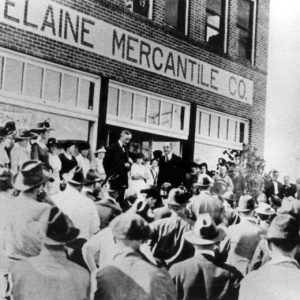 Charles Brough at Elaine
Charles Brough at Elaine 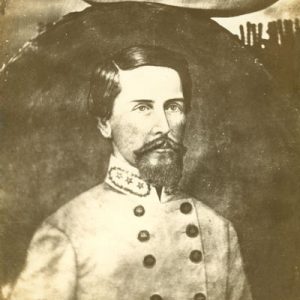 Patrick Cleburne
Patrick Cleburne 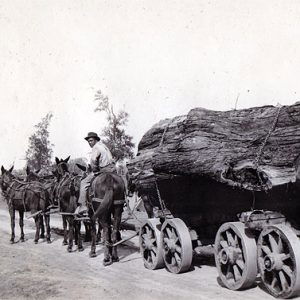 Cypress Logging
Cypress Logging  Delta Heritage Trail
Delta Heritage Trail 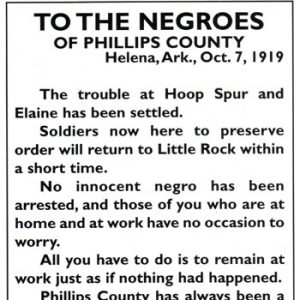 Elaine Massacre Flyer
Elaine Massacre Flyer 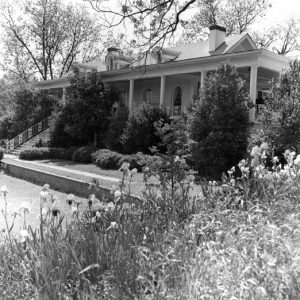 Estevan Hall
Estevan Hall 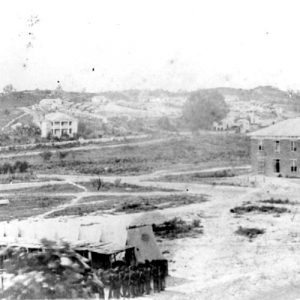 Helena Civil War Scene
Helena Civil War Scene  Helena-West Helena Bridge
Helena-West Helena Bridge 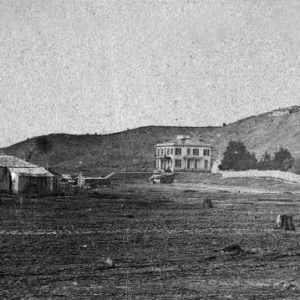 Thomas Hindman's Residence
Thomas Hindman's Residence 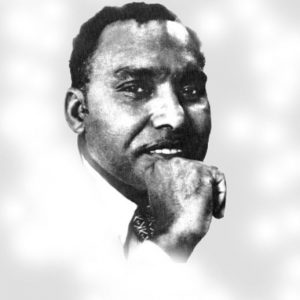 Samuel Kountz
Samuel Kountz  "Lonely Nights," Performed by CeDell Davis
"Lonely Nights," Performed by CeDell Davis 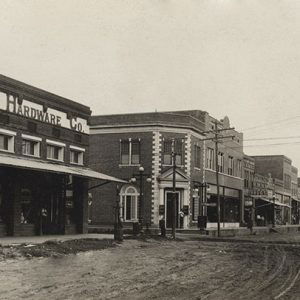 Marvell Street Scene
Marvell Street Scene 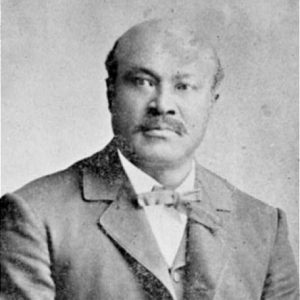 Abraham Miller
Abraham Miller  Lily Peter
Lily Peter 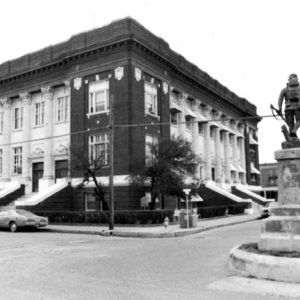 Phillips County Courthouse
Phillips County Courthouse 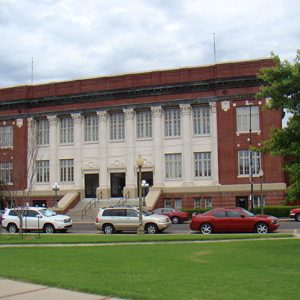 Phillips County Courthouse
Phillips County Courthouse 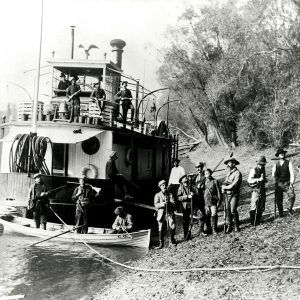 Phillips County Hunters
Phillips County Hunters 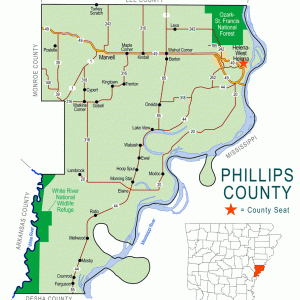 Phillips County Map
Phillips County Map 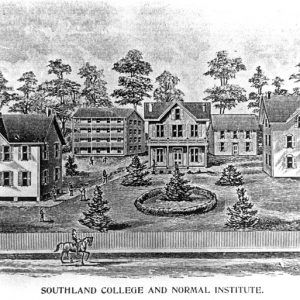 Southland College
Southland College 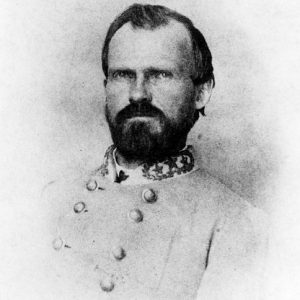 James Tappan
James Tappan 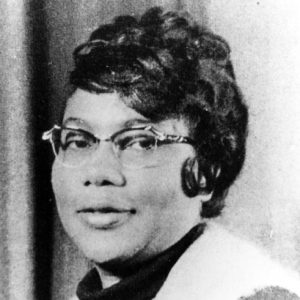 Annie Zachary
Annie Zachary 



Comments
No comments on this entry yet.